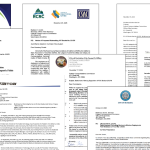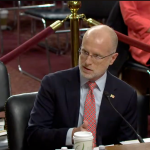
Last year, the U.S. Environmental Protection Agency (EPA) finalized the first national drinking water standards for six hazardous per- and polyfluoroalkyl substances (PFAS). Last week, the Trump administration announced that it would delay the timeline for implementing limits on two of those compounds and reconsider the limits on the remaining four.
There are more than 15,000 types of PFAS, and a growing body of research underscores the urgency of addressing them in water supplies. For decades, manufacturers have added the chemicals to products ranging from nonstick cookware to firefighting foam, earning them the nickname “forever chemicals” for their resistance to breaking down over time. These compounds now linger in soil, waterways, and human bloodstreams, with mounting evidence linking exposure to certain levels to some types of cancer, immune system damage, and other human health issues. Yet until recently, no comprehensive estimate of PFAS contamination in U.S. groundwater was available.
A study published in Science helps fill that gap. The research offers the first nationwide model of PFAS occurrence in untreated groundwater at depths commonly tapped for drinking water, estimating that up to 95 million people nationwide may rely on sources containing detectable levels of 24 types of these contaminants.
Mapping groundwater risks

Led by scientists at the U.S. Geological Survey (USGS), the study used machine learning modeling to map likely sites of PFAS contamination across the country. By combining key factors — including urban land use, industrial activity, proximity to PFAS-emitting facilities like airports and wastewater treatment plants, and geological variables like soil characteristics and aquifer depth — the model identified high-risk areas for detecting these contaminants in untreated groundwater.
“The coolest thing is just to be able to, for the first time, actually look at a national view of where we would expect to find PFAS in groundwater,” Andrea Tokranov, lead author of the study and a hydrologist at the USGS, told EHN.
The findings revealed contamination extending far beyond areas currently monitored by federal programs, with up to 13% of the contiguous U.S. land area potentially affected. Densely populated regions near industrial facilities, airports, and military bases emerged as hotspots, while the study showed that rural areas reliant on private wells also face unique vulnerabilities.
These results expose critical limitations of federal monitoring programs like the EPA’s Unregulated Contaminant Monitoring Rule, which requires testing for specific unregulated contaminants, including many PFAS, but excludes most private wells and small public water systems serving fewer than 3,300 people. These omissions leave millions of Americans without routine testing or treatment.
“In general, private homeowners with their own private drinking water wells are responsible for that testing and cost,” David Genereux, a hydrogeologist at North Carolina State University who studies how water and chemicals move through the environment, told EHN. Genereux was not involved in the study. PFAS, he explained, can persist in groundwater sites for decades or even centuries, creating long-term challenges for affected communities.
Unexpectedly, the model revealed urban land use as the strongest predictor of PFAS contamination, surpassing even proximity to known sources. This finding reflects the widespread use of PFAS in urban areas over decades, where detailed records of spills and emissions are often lacking.
“If there was some kind of release or some use that you didn’t document from 30 years ago, you will not be able to track that down reasonably,” said Tokranov, highlighting the challenge of addressing complex historical contamination.
Tools for targeted response
Predictive models like these can assist agencies in prioritizing their limited resources, especially given the high costs associated with PFAS testing, Jialin Dong, a civil and environmental engineer at the University of California, Irvine, who studies PFAS contamination, told EHN. Dong was not involved in the study, but said that national-scale findings, paired with localized results from research like her California-focused PFAS contamination model, “can help the government to identify which area or what kind of area they should focus on first.”
However, the authors caution against using the model to pinpoint risks at small scales, such as individual homes. “This is a national model,” Tokranov said. “You want to kind of zoom out, like statewide, look at what the patterns are across the state.” The tool provides a screening-level assessment, serving as a starting point for more targeted sampling and analysis.
As PFAS research evolves, so must predictive models. “As long as we have the data, we can refine models and incorporate new contaminants,” Dong said. However, she noted that progress is often hindered by the high costs and time demands of PFAS sampling and analysis, a bottleneck that limits widespread data collection.
The USGS team is already working on a next-generation model, aiming to move beyond binary predictions of contamination presence to estimate contamination levels. “It’s going to be tricky,” said Tokranov, referencing the additional data required for such an advancement. “But that’s where we’re headed.”
With PFAS contamination raising growing environmental and public health concerns, experts stress the need for swift action. “We need to regulate it in a short time,” said Dong. “Especially because with more PFAS research, we continue to see more health issues.”
The study represents a step forward in strengthening monitoring systems and improving drinking water protections, Genereux said. Its impact, however, will depend on how effectively its insights are integrated into policy and practice.
“Just seeing the broad national scope of the problem, hopefully, is something that keeps it in the forefront of regulators’ minds that this is big,” said Genereux. “It’s national. It’s not going to go away on its own, and it’s something that deserves a lot of attention.”





